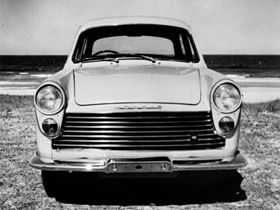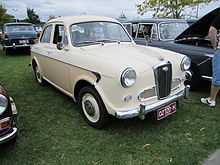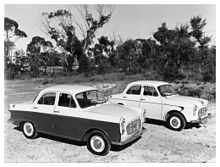Morris Major
- For the Morris Major automobile produced in the United Kingdom from 1931 to 1933, see Morris Major (1931 to 1933).
| Morris Major | |
|---|---|
 Morris Major Elite | |
| Overview | |
| Manufacturer | British Motor Corporation (Australia) |
| Also called | Austin Lancer |
| Production | 1958-1964 |
| Assembly | Victoria Park, Australia |
| Body and chassis | |
| Class | Compact |
| Body style | 4-door sedan |
| Layout | FR layout |
| Related | Wolseley 1500/Riley One-Point-Five |
| Powertrain | |
| Engine | BMC B-Series engine, 1489 & 1622 cc |
| Transmission | 4-speed manual, synchromesh on 2,3 & 4 |
| Dimensions | |
| Wheelbase | 92 in (2,300 mm) |
| Length | 161 in (4,100 mm) |
| Width | 61 in (1,500 mm) |
| Curb weight | up to 940 kg (2,072 lb) |
| Chronology | |
| Successor | Morris 1100 |
The Morris Major and Austin Lancer are passenger car models which were produced by the British Motor Corporation of Australia (BMC) between 1958 and 1964. The Morris Major name had been used before, by Morris Motors in England, for a six cylinder car produced from 1931 to 1933.[1]
Series I (1958 to 1959)
The Morris Major and Austin Lancer were introduced in 1958,[2] designated DO1101 and developed from the contemporary Wolseley 1500 and Riley One-Point-Five models [3] then on sale in the United Kingdom. The Major and Lancer, along with the Wolseley 1500 were produced at BMC Australia's Victoria Park plant [3] at Zetland in Sydney, Australia and were unique to that country, having around 98% local content.
The Morris Major/Austin Lancer/Wolseley 1500/Riley One-Point-Five all shared the same core design which had originally been developed as a possible replacement for the ever-popular Morris Minor by BMC's in-house design team at Longbridge, England. That plan was abandoned due to the Minor's unwavering appeal with the buying public and a Wolseley version was instead unveiled in 1957, followed by the Riley. They were light, close-coupled saloons incorporating the front torsion bar/rear leaf spring suspension, floorpan and superb rack and pinion steering from the Morris Minor. These automotive "quadruplets" were powered by the famous B series power unit (I4,) of 1489 cc. All were equipped with large, heavy duty drum brakes - by Lockheed for the Wolseley, Morris and Austin and Girling for the Riley. This formula resulted in a popular small-to-medium family car with lively performance, robust build and road manners that were quite above average for the time. The Major and Lancer, as distinct from the sportier and more luxurious Wolseley/Riley cars, shared a similar level of appointment, finish and engine tune with contemporary Morris and Austin models. Although comparatively modest, the Major/Lancer had a generally high level of comfort and quality: it was a modern car offering sound value. The sporting potential of the Major/Lancer was recognised almost immediately and specialist-modified cars were raced into the early 1960s.
 Morris Major Series I |
Austin Lancer Series I |
 Wolseley 1500 |
Series II (1959 to 1962)
The Morris Major and Austin Lancer Series II models, designated DO1115, were released in 1959.[4] The Series I Morris Major / Austin Lancer had sold reasonably well and was profitable to build due to greatly offset tooling costs and extensive use of shared components. However, BMC Australia quickly invested in the thoroughly re-engineered and subsequently better received Series II. Thenceforth, the Australian cars became quite distinctive from their siblings. Outwardly, the cars were now longer by 9 inches (229 mm), including an extended wheelbase, tailfins and new front sheetmetal. Series II's styling seems to have been more inspired by American ideas and, to many eyes, this gave the cars a more handsome appearance. Several updates to the original design were introduced, many of these changes intended to make the cars more suitable for the tough Australian conditions and to bolster its competitiveness with top selling rivals such as Holden and Volkswagen. The suspension was strengthened, extra reinforcement of the chassis was added and the interiors were given a front bench seat in place of buckets, ventilation and demisting ducts and a new instrument cluster. Also, the rear axle (a Morris Minor unit which in hindsight was not well-suited to the more powerful engine) had acquired an unfortunate reputation for weakness in Series I. The axle and differential were improved though, sadly, this early failing had already damaged the car's image and that of its maker. Series II's engine retained its single SU HS2 carburettor/SU fuel pump and received a modified oil sump to afford greater ground clearance. The Series II received highly favourable reviews from the motoring press of the time with its sweeping array of detail improvements, enhanced handling characteristics and attractive price earning much praise.


Morris Major Elite (1962 to 1964)
The Morris Major Elite, designated YDO1,[5] was introduced in March 1962.[6] It replaced the Series II models, supplanting the Austin Lancer range completely due to a change in BMC Australia's dealer network: there were now "BMC Dealers" only rather than separate outlets for each BMC Marque. It was seen as unnecessary to have two versions of the same vehicle, though a "Series III Lancer" had been considered right up to the Elite's introduction. The Elite was powered by the enlarged 1622 cc engine [7] with greater performance, this version now used a Zenith VN carburettor and Goss mechanical fuel pump. Telescopic rear shock absorbers, seatbelt mounting points and uprated front suspension rubbers featured among other technical revisions. A striking facelift was achieved with only minimal changes to sheet metal; this constituted chrome window surrounds, a new full-width grille closely resembling that of the Mk VI Morris Oxford, and a "rocket" colour flash on the tailfins. Some changes to basic equipment level included a fresh air heater/demister, duo-tone paint in various new plain and pastel colours, brighter interiors and a windscreen washer. The price was also lowered from the previous Series II list price, this made the already highly competitive Major outstanding value-for-money. Sales were fairly good and warranty claims were the least for any BMC (Aust.) model then to date. Production of the Elite ceased in 1964 when the model was replaced by the Morris 1100.[8]

References
- ↑ MORRIS MAJOR 1931 to 1933, International Alliance of Morris Owners Retrieved on 31 December 2012
- ↑ BMC-Leyland Australia Heritage Group, Building Cars in Australia, 2012, page 213
- ↑ 3.0 3.1 BMC-Leyland Australia Heritage Group, Building Cars in Australia, 2012, page 40
- ↑ BMC-Leyland Australia Heritage Group, Building Cars in Australia, 2012, page 76
- ↑ BMC-Leyland Australia Heritage Group, Building Cars in Australia, 2012, page 214
- ↑ BMC-Leyland Australia Heritage Group, Building Cars in Australia, 2012, page 201
- ↑ BMC-Leyland Australia Heritage Group, Building Cars in Australia, 2012, page 62
- ↑ BMC-Leyland Australia Heritage Group, Building Cars in Australia, 2012, page 132
External links
- Contemporary Press cuttings
- Magazine Archive
- Austin Lancer (Series II) sales brochure – 1960 Retrieved from austinlancer.tripod.com on 15 October 2009
- Morris Major Interest Group Major Obsession Network
| ||||||||||||||||||||||||||||||||||||||